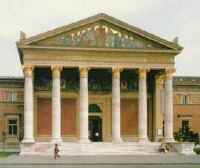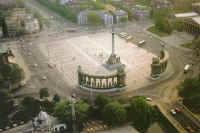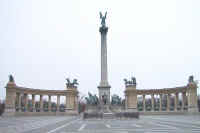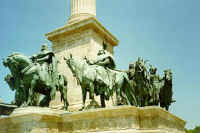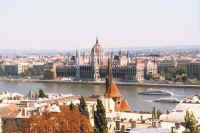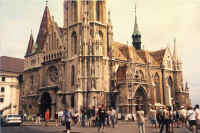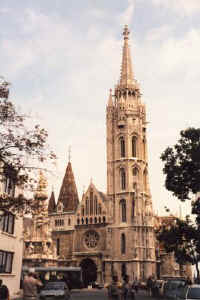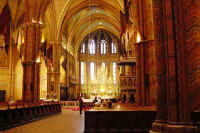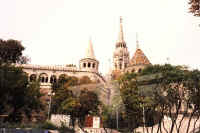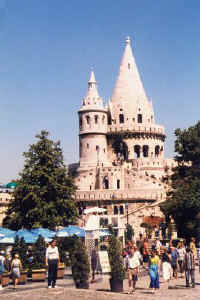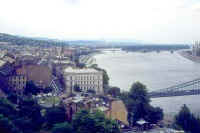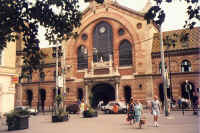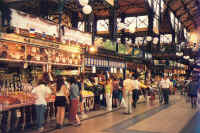|
Budapest Tuesday, 28 July: The breakfast buffet at the Intercontinental was more elaborate than at any of the previous hotels. They even made Belgian waffles and omelets to order. We found it difficult to stick to our resolution not to eat so much. By now we had discovered that the thing to do was skip lunch when it was not included in the tour. That helped a little, but we still ate too much.
The bus left at 9 a.m. for the Budapest city tour with a local guide. We drove along the Danube to the
Victory Bridge, past the Market Hall (1896), the National Museum (1846), the Great Synagogue (1859), and the
ornate Western Railway Station (1877), to City Park. Our main focus there was Heroes' Square, flanked by
the ornate Exhibition Hall (1905) and the Fine Arts Museum (1906). Many other attractions, mostly copies of
Hungary's historical monuments located elsewhere, but even a fairy tale castle, have been built in the park.
The centerpiece of the square is the Millennial Monument, built in 1896 to commemorate the 1000th anniversary
of Hungary's founding. It features seven horsemen, representing the seven Magyar tribes that came down from the Baltic
coast and conquered the land that became Hungary. (The word "Hungary" is thought to mean "ten tribes." The
other three tribes apparently settled in Finland, hence the similarity between the Hungarian and Finnish
languages.) The 350 foot column in the center of the square is topped by a statue of the Angel Gabriel holding
the Hungarian cross (with two horizontal bars, similar to the Cross of Lorraine) and the royal crown. The Tomb
of the Unknown Soldier is just in front of the column.
The bus next drove back toward the Danube, past the Opera House and St. Stephen's Basilica, to the Parliament Building, built between 1885 and 1906. Situated right on the bank of the Danube, the building was inspired somewhat by the British Houses of Parliament on the Thames, but it combines several styles, perhaps even a little Disneyland. Like many things we saw in Budapest, it was deliberately designed to be a tourist attraction, and it is. Sculptures of the seven Magyar chieftains and various Hungarian kings line the 885-foot facade along the river. The interior is also magnificent, but it is very difficult to get in except with a tour. Our tour did not go in, and we never found the time to arrange a visit. Our bus crossed the Danube and we visited Mathias Church and the Fishermen's Bastion, probably the city's most visited landmarks. There has been a church on this site since the early 12th century, but most of the present building is only about 100 years old. The church bears its name because King Mathias married Beatrix of Aragon (from Naples) here in 1476. He also added the tower to the church. The Gothic-style interior of the church was very beautiful, but it was jammed with tourists.
The Fishermen's Bastion is something else entirely. An original bastion on this site was torn down by the Austrians in 1849 after they suppressed the Hungarians in one of their periodic Wars of Independence. Fifty years later, the present white limestone bastion was built on the old foundations, but clearly more with a view to tourism than to defense. Disney himself could not have done better! Despite apocryphal stories about gallant fishermen defending the city, the name apparently comes from the fact that there was a fish market nearby. Our bus then drove by the Royal Palace and up to the top of Gellert Hill, around its citadel (also blown up by the Austrians), and stopped at a lookout point for a great view of the city and the Danube bridges. More on the Royal Palace later. When the bus returned us to the hotel, the two of us immediately caught a streetcar to the Market Hall. Built in 1896 specifically to house a public market, the entire ground floor is filled with stands selling food products of all kinds. The second floor is devoted mostly to the things tourists are apt to purchase, hand embroidered tablecloths and clothing, hand knit clothing, glass and, of course, post cards, T-shirts, and other souvenirs. It was interesting, but the only thing we bought was some Hungarian paprika. We walked back to the hotel on Vaci, the main pedestrian street. It had a wide variety of shops and stands. Overall, though, it was not as upscale as similar streets we've seen in other cities. At 4 p.m. we had a political lecture in the hotel by a university professor. It was excellent, focusing on the changes Hungary has made, and must still make, in moving from a communist country completely dominated by Russia, to a politically and economically free society trying to become part of "western" Europe. He predicted that, even though a left-of-center government had just been elected, Hungary would not regress in its efforts to meet the requirements for admission into the European Community. The professor also discussed Hungary's history. Unlike the Poles and Czechs, who seem quite content with their present borders, he revealed a strong resentment. Hungary was on the losing side in both World Wars. The professor pointed out that Hungary had included the entire Carpathian Basin for over 1000 years, though he acknowledge that much of that area was occupied by non-Magyars. When the Habsburg empire was dismantled after its defeat in World War II, Hungary was stripped of nearly three-quarters of its territory. Then, in return for a partial and short lived revision of its frontiers, Hungary allied itself with Nazi Germany in World War II. It lost still more territory when that war ended. Although the population of today's Hungary is more than 96% Magyar, over two million Magyars now live in Romania due to the border changes. There are also substantial numbers of Magyars in Slovakia and Serbia, which also were once part of Hungary. Of course, there are over a million Magyars in the United States, but no one complains about that because they left Hungary voluntarily. We really enjoyed the lecture. After resting for a couple of hours, we met Elaine and the Kimmins brothers around 7:30 at Szazeves, the oldest restaurant in Budapest. We tried the cold fruit soup as the first course. It came with a large glob of whipped cream and was a little sweet, but very tasty. The chicken paprika was very good, and there were strolling musicians and lots of gypsy music. We finally walked back to the hotel about ten.
Copyright © 2000-2023 DarrellPeck.com All rights
reserved. | ||||

